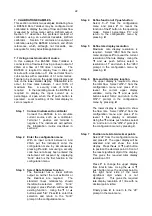
9. ACCESSORIES
9.1 Units of measurement & instrument
identification.
The BA554E Rate Totaliser is fitted with a blank
escutcheon around the liquid crystal display. This
can be supplied printed with any units of
measurement and tag information specified at the
time of ordering. Alternatively, the information may
be added on-site via an embossed strip, dry
transfer or a permanent marker.
To gain access to the display label remove the
terminal cover by unscrewing the two 'A' screws
which will reveal two concealed 'D' screws. Also
unscrew the two 'C' screws securing the keypad
cover and un-plug the five way connector. Finally
unscrew all four 'D' screws and carefully lift off the
front of the instrument. The location of all the
screws is shown in Fig 4.
Add the required legend to the display escutcheon,
or stick a new pre-printed self-adhesive
escutcheon, which is available from BEKA
associates, on top of the existing escutcheon. Do
not remove the original escutcheon.
The BA554E Rate Totaliser can also be supplied
with a blank or custom laser engraved stainless
steel plate secured by two screws to the front of
the instrument enclosure. This plate can
accommodate:
1 row of 9 alphanumeric characters 10mm high
or 1 row of 11 alphanumeric characters 7mm high
or 2 rows of 18 alphanumeric characters 5mm
high.
9.2 Alarms
CAUTION
These alarms outputs should not be used
for critical safety applications such as an
emergency shut down system.
The BA554E Rate Totaliser can be supplied with
factory fitted dual alarms with solid state, single
pole outputs. Each output may be independently
configured as a rate or total, high or low alarm with
a normally open or normally closed output in the
non-alarm condition.
When the 4/20mA current powering the Rate
Totaliser is removed both alarm outputs will open
irrespective of configuration. The open circuit
condition should therefore be chosen as the alarm
condition when designing an alarm system.
Fig 10 illustrates the conditions available and
shows which are fail safe.
When an alarm occurs an alarm annunciator on
the Rate Totaliser display is activated and if
required the rate or total display causing the alarm
can alternate between the measured value and the
alarm channel identification ‘ALr1’ or ‘ALr2’.
Fig 10 Alarm outputs
Configurable functions for each alarm include
activation from rate display or total display,
adjustable setpoint, hysteresis, alarm delay and
alarm silence time.
26








































